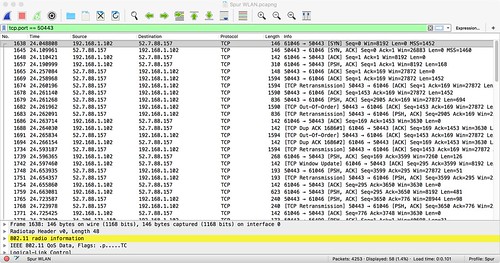


- #Wireshark promiscuous mode wired how to
- #Wireshark promiscuous mode wired mac os x
- #Wireshark promiscuous mode wired install
- #Wireshark promiscuous mode wired driver
#Wireshark promiscuous mode wired how to
The Display Filter box is used to control which packets Wireshark shows in the packet list, details on how to use this are in the Filtering Packet Captures tab. Restart Capture is only available once a packet capture has been started or stopped, this clears the packet list and restarts the capture Stop Capture will stop an active packet capture and allow the packet capture to be saved into a file Start Capture will start a packet capture on all selected interfaces

To start capturing packets, it's necessary to select the interface to capture from, which is set from the List of Capture Interfaces and Capture Options windows. The important menu options are located in the main toolbar: The application will initially show the main screen:
#Wireshark promiscuous mode wired install
Install the application (which will include WinPcap, a separate program that facilitates the capturing of network traffic by the Wireshark program) and run it once it has installed successfully.

Libpcap 1.0.0 and later provides an API to select monitor mode when capturing on those operating systems.Download Wireshark from here.
#Wireshark promiscuous mode wired mac os x
In Mac OS X 10.4 and later releases, the drivers for AirPort Extreme network adapters allow the adapter to be put into monitor mode. FreeBSD, NetBSD, OpenBSD, and DragonFly BSD also provide an interface for 802.11 drivers that supports monitor mode, and many drivers for those operating systems support monitor mode as well.
#Wireshark promiscuous mode wired driver
STA drivers ( Ralink, Broadcom) and every other manufacturer’s provided driver doesn’t support monitor mode. Linux's interfaces for 802.11 drivers support monitor mode and many drivers offer that support. įor versions of Windows prior to Windows Vista, some packet analyzer applications such as Wildpackets' OmniPeek and TamoSoft's CommView for WiFi provide their own device drivers to support monitor mode. For example, Ralink drivers report incorrect dBm readings and Realtek drivers do not include trailing 4-byte CRC values. In many cases, monitor mode support is not properly implemented by the vendor. The implementation details and compliance with the NDIS specifications vary from vendor to vendor. Monitor mode support in NDIS 6 is an optional feature and may or may not be implemented in the client adapter driver. NDIS 6 supports exposing 802.11 frames to the upper protocol levels, while previous versions only exposed fake Ethernet frames translated from the 802.11 frames. The Microsoft Windows Network Driver Interface Specification (NDIS) API has supported extensions for monitor mode since NDIS version 6, first available in Windows Vista. Also, in monitor mode the adapter does not check to see if the cyclic redundancy check (CRC) values are correct for packets captured, so some captured packets may be corrupted. Usually the wireless adapter is unable to transmit in monitor mode and is restricted to a single wireless channel, though this is dependent on the wireless adapter's driver, its firmware, and features of its chipset. Software such as KisMAC or Kismet, in combination with packet analyzers that can read pcap files, provide a user interface for passive wireless network monitoring. This helps to create a better Wi-Fi network that reduces interference with other Wi-Fi devices by choosing the least used Wi-Fi channels. For a given area and channel, the number of Wi-Fi devices currently being used can be discovered. Monitor mode can also be used to help design Wi-Fi networks. It is especially useful for auditing unsecure channels (such as those protected with WEP). Uses for monitor mode include: geographical packet analysis, observing of widespread traffic and acquiring knowledge of Wi-Fi technology through hands-on experience.


 0 kommentar(er)
0 kommentar(er)
